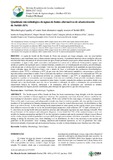Qualidade microbiológica de águas de fontes alternativas de abastecimento do Seridó (RN)

Data
2020-01-13Autor
Medeiros, Isandra
Coelho, Raquel
Félix, Isângela
Leite, Antônio
Vieira, Francisca
Araújo, Ana Luiza
Metadado
Mostrar registro completoResumo
The Serido region of Rio Grande do Norte has been experiencing a long drought, with this important
reservoirs that contribute to human supply have dried up. The population concerned about the adverse conditions has
been looking for alternative sources of water supply. Wells were drilled for the daily supply of various communities.
Water is life, and it is necessary and indispensable to make sure that it is used in a potable, safe way and that it meets the
standards of the legislation for human consumption, however it must be treated when necessary, for distribution, so that
there is no risk to society. To this end, betting on the improvement of water quality in this region, waters were collected
from different sources in order to verify the microbiological parameters, total coliforms (35 ° C) and coliforms at 45 °
C, since these are strong health indicators and their presence and subsequent ingestion can cause damage to health. With
the performance of the analyzes and subsequent diagnosis, it was found that 33% of the analyzed samples were not
suitable for human consumption and that 67% met the legislative standards and can be consumed without concern. Based
on the results, simple technical guidelines were provided, through conversations with those responsible for the sources,
aiming at taking the necessary care, from obtaining it to its distribution, for this it was necessary to use actions and
guidelines in the procedures. basic cleaning, sanitation and treatment operations, as well as guidelines that value
behavioral attitudes of personal and environmental hygiene, in order to obtain drinking water that does not offer risks.



